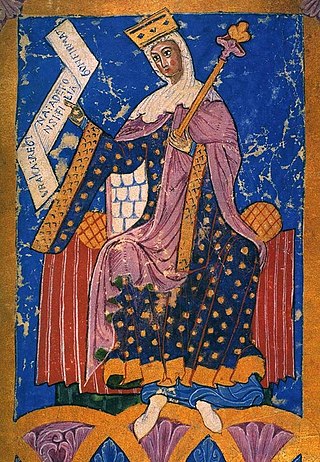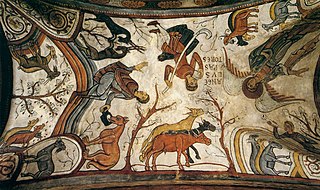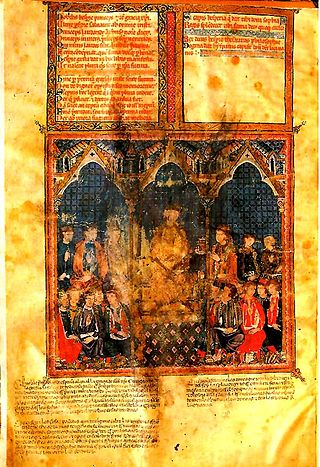
Alfonso IX was King of León and Galicia from the death of his father Ferdinand II in 1188 until his own death.
Alfonso VIII, called the Noble or the one of Las Navas, was King of Castile from 1158 to his death and King of Toledo. After having suffered a great defeat with his own army at Alarcos against the Almohads in 1195, he led the coalition of Christian princes and foreign crusaders who broke the power of the Almohads in the Battle of Las Navas de Tolosa in 1212, an event which marked the arrival of a tide of Christian supremacy on the Iberian peninsula.

Berengaria, nicknamed the Great, was Queen of Castile for a brief time in 1217, and Queen of León from 1197 to 1204 as the second wife of King Alfonso IX. As the eldest child and heir presumptive of Alfonso VIII of Castile, she was a sought after bride, and was engaged to Conrad, the son of Holy Roman Emperor Frederick I. After Conrad's death, she married her cousin Alfonso IX of León to secure the peace between him and her father. She had five children with him before their marriage was voided by Pope Innocent III.

Bernardo del Carpio is a legendary hero of the medieval Spain. Until the end of the nineteenth century and the labors of Ramón Menéndez Pidal, he, not El Cid, was considered to have been the chief hero of medieval Christian Spain and was believed to be a historical person. His factual existence has been defended in the later 20th century, although the Spanish government has not designated him to be historical.

Urraca of León and Castile, called "the reckless" (la temeraria), was Queen of León, Castile and Galicia from 1109 until her death. She claimed the imperial title as suo jure Empress of All Spain and Empress of All Galicia.

The Battle of Uclés was fought on 29 May 1108 during the Reconquista period near Uclés just south of the river Tagus between the Christian forces of Castile and León under Alfonso VI and the forces of the Muslim Almoravids under Tamim ibn-Yusuf. The battle was a disaster for the Christians and many of the high nobility of León, including seven counts, died in the fray or were beheaded afterwards, while the heir-apparent, Sancho Alfónsez, was murdered by villagers while trying to flee. Despite this, the Almoravids could not capitalise on their success in the open field by taking Toledo.
The Battle of Calatañazor was a legendary battle of the Reconquista that supposedly took place in July 1002 in municipality Calatañazor in the province of Soria between an army of invading Moors under Almanzor and a force of Christian allies led by Alfonso V of León, Sancho III of Navarre, and Sancho García of Castile. Almanzor, who historically died the night of 10–11 August, is said to have died of wounds received in the battle. The battle of Calatañazor has been branded as unreal since the 18th century due to the non-existence of any evidence in the chronicles of the time. Its ahistoricity was first demonstrated by Reinhart Dozy in 1881. The French Arabist Évariste Lévi-Provençal attributed the destruction of San Millán de la Cogolla by the Saracens to the campaign in municipality Calatañazor.

Alfonso de Santa María de Cartagena was a Jewish convert to Christianity, a Roman Catholic bishop, diplomat, historian and writer of pre-Renaissance Spain.

Alfonso X of Castile, also known as Alfonso the Wise, ruled from 1252 until 1284. One of Alfonso’s goals for his kingdom was to lift Castile out of the Dark Ages by producing a united, educated, artistic, and religious population. His desire to bring Castile into the mainstream of high civilization led to a boom of cultural activity, including the production and translation of a great deal of literature. The literature produced during his reign was intended to aid him in achieving his goal by giving the common people of Spain access to great intellectual works. Therefore, all of the prose attributed to Alfonso X’s efforts was written in the language of the common people, Castilian, rather than Latin, which was the language of prestige at that time. Although the works are generally attributed to Alfonso X, being a king with other business to deal with he did not himself write most of them. Instead, Alfonso’s role was that of choosing works to be produced and translated, funding the projects, selecting the true authors of the work, overseeing the production, and occasionally contributing personally.
The Chronica Naierensis or Crónica najerense was a late twelfth-century chronicle of universal history composed at the Benedictine monastery of Santa María la Real in Nájera. In Latin it narrates events from Creation to its own time, with a focus on the Bible, classical history, the Visigothic in Spain, and the kingdoms of Castile and León. It was an important model for later Spanish Latin historiographers, notably the De rebus Hispaniae of Rodrigo Jiménez de Rada, the Chronicon mundi of Lucas de Tuy, and the Estoria de España of the patronage of Alfonso X of Castile.

Sampiro (c. 956 – 1041) was a Leonese cleric, politician, and intellectual, one of the earliest chroniclers of post-conquest Spain known by name. He was also the Bishop of Astorga from 1034 or 1035 until his death.

The Historia silense, also called the Chronica silense or Historia seminense, and more properly Historia legionense, is a medieval Latin narrative history of the Iberian Peninsula from the time of the Visigoths (409–711) to the first years of the reign of Alfonso VI of León and Castile (1065–1073). Though originally intended as a gesta of Alfonso, it is primarily an original account of the reign of his father, Ferdinand I (1037–1065). For its earlier history it relies on the works of Isidore of Seville, Julian of Toledo, and the Vitas sanctorum patrum Emeritensium for the Visigothic period, the Chronicle of Alfonso III for the ninth century, the work of Sampiro for the tenth and early eleventh centuries, and the Chronicon of Pelayo of Oviedo for the eleventh century. The Historia along with Pelayo's Chronicon provide the only surviving versions of Sampiro's otherwise lost history.
The Chronicon Compostellanum is a narrative Latin chronicle of the history of Spain from the arrival of the Visigoths until the death of Queen Urraca of León on 8 March 1126. It was probably written shortly after this date, and probably in Galicia. It covers the history of the Visigothic kingdom and their successors, the Kingdom of Asturias, rapidly, incorporating the Laterculum regum ovetensium, a regnal list of the Asturian monarchy from Pelagius to Alfonso II written sometime after 791 and also incorporated in the Chronicon Iriense and the Annales Portugalenses veteres. For the eleventh-century Kingdom of León it is the earliest surviving source after the Historia silense (1109–18). The cause of Urraca's death—in labour with the child of her lover, Pedro González de Lara—is recorded in the Chronicon. Its first editor and publisher, Enrique Flórez, in his twenty-eighth preliminary note to the appendix of Latin documents in the twenty-third volume of his España Sagrada, described the text thus:

Nuño Rasura was one of two legendary judges of Castile, the other being his son-in-law Laín Calvo. According to the Mocedades de Rodrigo, Nuño gained the nickname "Rasura" because "he took from Castile equal measures of wheat" to offer as a gift to Church of Saint James. English medievalist Richard A. Fletcher writes that "the legend of the judges has more to tell us of the Castilians' self-image at a later date than of the realities of the ninth century: they liked to think of themselves as sturdy, independent, resourceful, democratic."

Pelagiusof Oviedo was a medieval ecclesiastic, historian, and forger who served the Diocese of Oviedo as an auxiliary bishop from 1098 and as bishop from 1102 until his deposition in 1130 and again from 1142 to 1143. He was an active and independent-minded prelate, who zealously defended the privileges and prestige of his diocese. During his episcopal tenure he oversaw the most productive scriptorium in Spain, which produced the vast Corpus Pelagianum, to which Pelagius contributed his own Chronicon regum Legionensium. His work as a historian is generally reliable, but for the forged, interpolated, and otherwise skilfully altered documents that emanated from his office he has been called el Fabulador and the "prince of falsifiers". It has been suggested that a monument be built in his honour in Oviedo.

The Estoria de España, also known in the 1906 edition of Ramón Menéndez Pidal as the Primera Crónica General, is a history book written on the initiative of Alfonso X of Castile "El Sabio", who was actively involved in the editing. It is believed to be the first extended history of Spain in Old Spanish, a West Iberian Romance language that forms part of the lineage from Vulgar Latin to modern Spanish. Many prior works were consulted in constructing this history.
The Chronica latina regum Castellae, known in Spanish as the Crónica latina de los reyes de Castilla, both meaning "Latin Chronicle of the Kings of Castile", is a medieval Latin history of the rulers of Castile from the death of Count Fernán González in 970 to the reconquest of Córdoba by King Ferdinand III in 1236–39. It was probably composed by Juan de Soria, the Bishop of Osma and chancellor of Ferdinand III, between 1217 and 1239. The majority of the text deals with the reigns of Alfonso VIII (1158–1214) and Ferdinand III (1217–1252). It was designed with two purposes: for use at the royal court as a speculum principis and to defend the interests of Castile against those of the Kingdom of León.

According to some sources, Bardulia is the ancient name of the territories that composed the primitive Castile in the north of what later became the province of Burgos. The name comes from Varduli, the name of a tribe who, in pre-Roman and Roman times, populated the eastern part of the Cantabrian coast of the Iberian peninsula, primarily in present-day Guipúzcoa. Some assert that the Varduil also encompassed or assimilated the Caristii and Autrigones.
Sancha Raimúndez of León was a Leonese infanta, the daughter of Queen Urraca and Raymond of Burgundy and the older sister of Alfonso VII of León.
Ferdinand was an infante, the second son and heir apparent of Alfonso VIII of Castile by his wife, Eleanor of England. He died unmarried at the age of 22, a little less than three years before his father.












